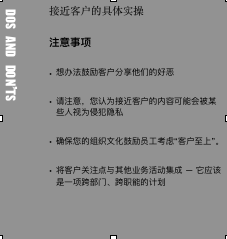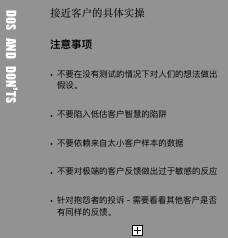One of the big things about effective marketing is to assess customers’ needs , and it is the basis of any business operation. The approaches detailed here, based on Leithon consulting practices, focuses on how to identify your customers’ needs, but does not extend to suggesting ways of meeting those needs.
Define “Closeness to the Customer”
Getting close to the customer involves gathering facts and knowledge about your customers (current and potential) in order to develop an awareness of what customers want from you and how they perceive your organization and its products or services. This awareness in turn enables you to continuously strive to meet your customers’ demands and secure your organization’s long-term survival and profitability.
“I look in my closet, and if I need it, I design it. If it works for me, it works for the customer. ”
——Donna Karan
Advantages
Being close to your customers allows you to:
respond to changes in demand and in the market
act on facts rather than hunches or intuition
develop products or services better tailored to your target market
achieve improved sales and increased profits
Disadvantages
The advantages of being close to your customers far outweigh any disadvantages, but you should take the following factors into account.
The better you try to get know customers, the more you risk intruding on their privacy
If you ask a customer to reveal personal or valuable information, then you’ll probably have to offer a reward or benefit in return.
Customers may resist telling you personal information and may not always tell the truth.
Surveys and research can be costly and time-consuming.
Action Checklist
Managers need to run through the followings:
1.Examine your organizational culture
You are unlikely to get close to your customers unless the culture of your organization encourages such as relationship. Stall should be trained to think ‘customer first’—those who are not customer-focused can jeopardize the success of the organization by making inappropriate decisions, failing to respond to changing situations appropriately or quickly enough, or neglecting to serve customers in a way that promotes their loyalty.
Remember that every section of your organization has customers. Staff in direct contact with external customers cannot provide effective service without the internal support of colleagues all along the chain. To encourage internal service departments to adopt an outward-looking customer focus, their operators might work for a week or two in the department they service.
2. Identify your customers
Your customers are those who use the output of your work. They may be internal to your organization(for example, your HR function has all employees as its customers) or external (members of the public, other businesses, or government or public bodies). When identifying customers, distinguish between purchasers, those who pay for your product, and end users, those who actually use it.
You will probably wish to compile a database of your customers so that you can profit your customer base. Bear in mind that any recoding of an individual’s person details must comply with the requirements of related Data Protection Act (Regulations).
3. Profile your customers
A wide range of factors influences customer behavior and choices, for example:
gender—particularly where the purchaser or end user is not the sole decision-maker
age—different age ranges being more susceptible to targeting by some products than others
marital status—especially combined with other factors such as children and disposable income
home ownership—indicating specific needs and responsibilities that relate to buying patterns
location—urban consumers differing from rural ones and regions differing culturally and economically
lifestyle—since all customers have individual activities, interests, and opinions
These factors become more useful when they are analyzed in combination—for example, home ownership, age, and number of dependent children can indicate the likely amount of a customer’s disposable income.
Decide how to approach your customers to find out their basic characteristics. It may not be possible to ask every customer individually, but other fruitful approaches exist, for example:
market research
questionnaires
user-or focus-group discussions
customer audits
attitude surveys
Take advantage of opportunities to meet business customers at their premises or at yours in a series of open days or customer care programs or through membership of user groups, industry liaison meetings, or partnerships arising out of new product development.
4. Assess your customers’ opinions and attitudes
Organizations with an inaccurate perception of their customers’ needs most likely:
make untested and unwarranted assumptions about what customers think
rely on weak anecdotal evidence, attaching too much importance to isolated incidents
accord too much weight to atypical complaints, particularly the opinions of small numbers of highly articulate customers
If you don’t make the effort to find out what your customers think, you can be caught off-balance when they go elsewhere. If you don’t know why they are going elsewhere, you can’t identify corrective actions. In addition to basic factual information about your customers, find out:
why customers buy your product or use your service
how they use it
what their opinion is of your product or service
why they choose your offering one the competition
what their experience is of your product or service in terms of performance and after-sales care
Attitudes and opinions are hard to quantify, and many factors influence a decision to purchase or to remain loyal to a particular brand. Customers may be influenced as much or more by their impressions of service—-courtesy, promptness, etc. —as by the quality of a product. Exploring these issues requires detailed research , and if you don’t have adequate in-house expertise you may wish to use an external research agency.
Be sure to listen to your front-line staff, who are on the receiving end of first-hand comments from customers about their satisfaction and dissatisfaction. Consider setting up a procedure for reporting this information.
“If the shoe doesn’t fit, must we change the foot? ”
——Gloria Steinem
5. Act on your findings
Analyze the results of your research, interpret the data, and publicize your findings. Use your findings to work out where you need to take action to maintain your competitive advantage. Involve all staff in this process; encourage everyone to think ‘customer first’.
Paying attention to your customers’ needs is an on-going process. Consider setting up a regular research project to customer audit, introducing customer suggestion schemes with response mechanisms, or initiating a scheme to constantly monitor your market.


6. Give feedback to customers
Let your customers know that you have taken on board their needs and their ideas. This may publishing a revised mission statement reiterating your commitment to fulfilling their needs, or publishing survey results and details of new products or product amendments made as a result of the research.
Feedback is not a one-off event. It needs to be a continuous process that informs customers of your organization’s response to suggestions, mistakes, and new ideas and that encourages further dialogue.
Thoughts Staters
When was the last time you spoke to, or came into contact with, a customer?
Do you know who buys your product and why?
Do customers talk as much about competitors’ product as yours?
How easy is it for your customers to complain and give feedback?